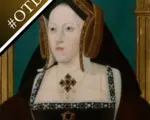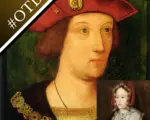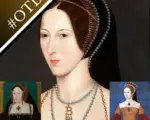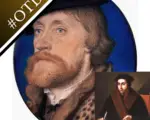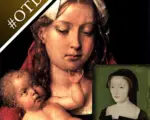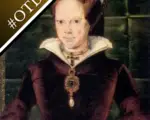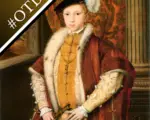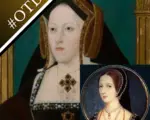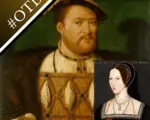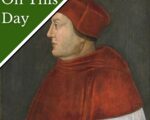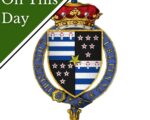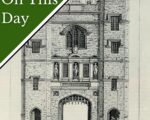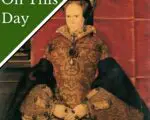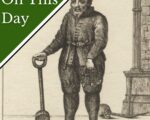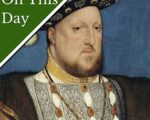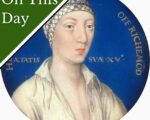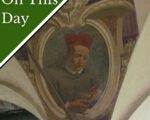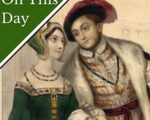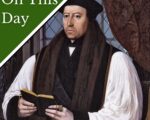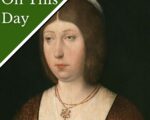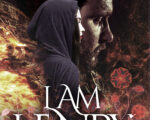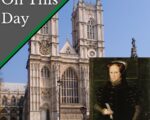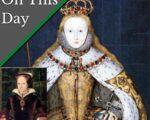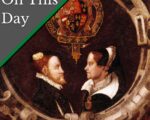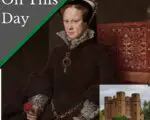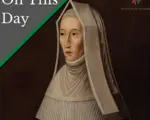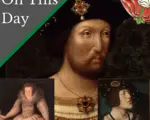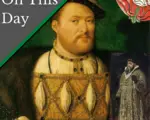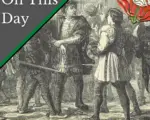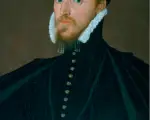
On 4th February 1520, Mary Boleyn married William Carey, a young, handsome, athletic man who a member of the King Henry VIII's household and also a distant cousin of the King. The match was well made, as Mary Boleyn's father, Sir Thomas Boleyn, was on the rise and was making a name for himself at court. The wedding took place at Greenwich and Henry VIII himself was present, giving the newly married couple a gift of 6s 8d.
Mary would go on to give her husband two healthy children. Mary's first child, a daughter named Catherine, quite possibly named after Queen Catherine of Aragon, was born in 1524. Catherine would become a constant figure at court until her death on 15 January 1569. At the age of just fourteen, she was appointed as a maid of honour to Anne of Cleves, Henry VIII's fourth wife. Then, on 26 April 1540, Catherine married Sir Francis Knollys and she went on to give her husband thirteen children! After the deaths of Henry VIII and his son and heir Edward VI, the Catholic Mary I came to the throne. As Protestants, Catherine and Francis feared for their safety and fled the country with their youngest children. Catherine and her family spent several years travelling the Low Countries, where Catherine was to give birth to one of her children.
Upon Mary I's death, Elizabeth I came to the throne and in 1559 Catherine was appointed as a lady of the Queen's bedchamber. Returning to England, Catherine took up this highly prized position. Her status meant that she was to tend to the Queen's personal needs, sleep at the foot of her bed when required and help dress the Queen, among other duties. It was a position of intimacy and one which Elizabeth I came to cherish.
Tragically, Catherine died on 15 January 1569 at Hampton Court. Queen Elizabeth I is reported to have been grief-stricken and she gave her beloved cousin a lavish burial at Westminster Abbey which cost £640 2s. 11d.
Mary Boleyn's second child, a son named Henry, was born on 4 March 1526. He too would become a prominent and impressive member at court throughout his life. In May 1545 he married Anne Morgan and the pair had twelve children together, nine of them sons. During his early years, he became a diplomat and a member of parliament. When Elizabeth I came to the throne, Henry was knighted and on the 13 January 1559 he was created Baron Hunsdon and granted substantial lands and a yearly pension of £4000. On 31 October 1560 Henry was appointed as Master of the Queen's hawks and then on 18 May 1561 he was created a Knight of the Garter.
Henry Carey played a prominent role over the years helping to protect the North from England's Scottish neighbours. On 23 October 1571, he was appointed warden of the east marshes, which afforded him even greater responsibilities in protecting the north of England. On the 16 November 1577, Henry was appointed as a member of the Privy Council, allowing him greater access not only to the Queen but to the administration of England's policies.
During 1583, Elizabeth I re-appointed Henry as captain of the gentlemen pensioners and in July 1585 he was appointed as Lord Chamberlain of the Household, as well as continuing his privy councillor duties. Henry was active in political life until his death on 23 July 1596 at Somerset House. Just like his sister Catherine, Henry Carey was buried at Westminster Abbey, the expenses of this paid by his cousin Elizabeth I. It is rumoured that on his deathbed Elizabeth I offered Henry the earldom of Wiltshire, a title held by his grandfather Thomas Boleyn. However, Henry refused the title stating that if Elizabeth did not think him worthy of the title while he was alive he would not accept it now that he was dying.
Elizabeth I died childless in 1603 and it was through Catherine and Henry's children that the Boleyn bloodline continued.
Sarah Bryson is the author of Mary Boleyn: In a Nutshell. She is a researcher, writer and educator who has a Bachelor of Early Childhood Education with Honours and currently works with children with disabilities. Sarah is passionate about Tudor history and has a deep interest in Mary Boleyn, Anne Boleyn, the reign of Henry VIII and the people of his court. Visiting England in 2009 furthered her passion and when she returned home she started a website, queentohistory.com, and Facebook page about Tudor history. Sarah lives in Australia, enjoys reading, writing, Tudor costume enactment and wishes to return to England one day.
Notes and Sources
- Jonathan Hughes, ‘Stafford , Mary (c.1499–1543)’, Oxford Dictionary of National Biography, Oxford University Press, 2004; online edn, Jan 2009, http://www.oxforddnb.com/view/article/70719, accessed 6 June 2015.
- Sally Varlow, ‘Knollys , Katherine, Lady Knollys (c.1523–1569)’, Oxford Dictionary of National Biography, Oxford University Press, Oct 2006; online edn, Jan 2009 http://www.oxforddnb.com/view/article/69747, accessed 6 June 2015.
- Wallace T. MacCaffrey, ‘Carey, Henry, first Baron Hunsdon (1526–1596)’, Oxford Dictionary of National Biography, Oxford University Press, 2004; online edn, Sept 2014, [http://www.oxforddnb.com/view/article/4649accessed 6 June 2015.
- Weir, Alison (2011) Mary Boleyn: The Mistress of Kings, Ballantine Books, New York.
- Wilkinson, Josephine (2010) Mary Boleyn: The True Story of Henry VIII’s Favourite Mistress, Amberley Publishing, Gloucestershire.


